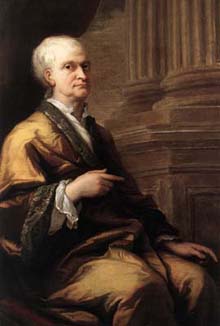
Sir Isaac Newton (born 25 December 1642)
The life cycle 124875
Important years of life
1679 5
1684 1
1685 2
1687 4
1691 8
1699 7
1706 5
1711 1
1712 2
1714 4
1718 8
1726 5
wiki information https://en.wikipedia.org/wiki/Isaac_Newton
In 1679, Newton returned to his work on (celestial) mechanics by considering gravitation and its effect on the orbits of planets with reference to Kepler’s laws of planetary motion. This followed stimulation by a brief exchange of letters in 1679–80 with Hooke, who had been appointed to manage the Royal Society’s correspondence, and who opened a correspondence intended to elicit contributions from Newton to Royal Society transactions
Newton later became involved in a dispute with Leibniz over priority in the development of calculus (the Leibniz–Newton calculus controversy). Most modern historians believe that Newton and Leibniz developed calculus independently, although with very different notations. Occasionally it has been suggested that Newton published almost nothing about it until 1693, and did not give a full account until 1704, while Leibniz began publishing a full account of his methods in 1684. (Leibniz’s notation and “differential Method”, nowadays recognised as much more convenient notations, were adopted by continental European mathematicians, and after 1820 or so, also by British mathematicians.) But such a suggestion fails to account for the content of calculus in Book 1 of Newton’s Principia itself (published 1687) and in its forerunner manuscripts, such as De motu corporum in gyrum (“On the motion of bodies in orbit”) of 1684; this content has been pointed out by critics of both Newton’s time and modern times. The Principia is not written in the language of calculus either as we know it or as Newton’s (later) ‘dot’ notation would write it. His work extensively uses calculus in geometric form based on limiting values of the ratios of vanishing small quantities: in the Principia itself, Newton gave demonstration of this under the name of ‘the method of first and last ratios'[24] and explained why he put his expositions in this form, remarking also that ‘hereby the same thing is performed as by the method of indivisibles’.
Because of this, the Principia has been called “a book dense with the theory and application of the infinitesimal calculus” in modern times and “lequel est presque tout de ce calcul” (‘nearly all of it is of this calculus’) in Newton’s time. His use of methods involving “one or more orders of the infinitesimally small” is present in his De motu corporum in gyrum of 1684 and in his papers on motion “during the two decades preceding 1684”
…Newton communicated his results to Edmond Halley and to the Royal Society in De motu corporum in gyrum, a tract written on about nine sheets which was copied into the Royal Society’s Register Book in December 1684. This tract contained the nucleus that Newton developed and expanded to form the Principia.
His book Philosophiæ Naturalis Principia Mathematica (“Mathematical Principles of Natural Philosophy”), first published in 1687, laid the foundations of classical mechanics.
The Principia was published on 5 July 1687 with encouragement and financial help from Edmond Halley.
5 July 1687 = 1699
Starting in 1699, other members of the Royal Society (of which Newton was a member) accused Leibniz of plagiarism. The dispute then broke out in full force in 1711 when the Royal Society proclaimed in a study that it was Newton who was the true discoverer and labelled Leibniz a fraud. This study was cast into doubt when it was later found that Newton himself wrote the study’s concluding remarks on Leibniz. Thus began the bitter controversy which marred the lives of both Newton and Leibniz until the latter’s death in 1716.
Isaac Newton in old age in 1712, portrait by Sir James Thornhill
Newton died in his sleep in London on 20 March 1726/1727
(OS 20 March 1726; NS 31 March 1727)